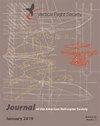垂直升降应用的运动病发病预测
IF 1.4
4区 工程技术
Q2 ENGINEERING, AEROSPACE
引用次数: 0
摘要
可以预见,在即将到来的(电动)城市空中出租车的应用中,乘坐的舒适性,特别是晕动病的体验,将在乘客的接受度和这些车辆的经济成功方面发挥至关重要的作用。因此,需要精确的晕动病预测模型,这些模型以后可以用于例如运动缓慢轨迹的生成。然而,像ISO 2631标准这样建立的晕动病模型只考虑了垂直平移轴而没有旋转轴。为此,选择并修正了6自由度的Kamiji晕动病模型,以避免该模型预测结果不理想的问题。然后,采用基于已发表实验数据的优化方法返回该模型的参数。然后表明,使用这种方法,改进的Kamiji模型更适合预测该数据集的晕动病结果。未来,该模型将在DLR的BO-105直升机上进行一系列的飞行测试和验证。本文章由计算机程序翻译,如有差异,请以英文原文为准。
Prediction of Motion Sickness Onset for Vertical Lift Applications
It is foreseen that in the upcoming application of (electric) urban air taxis, the comfort of ride and especially the experience of motion sickness will play a vital role in acceptance among passengers and therefore economic success of these vehicles. For this reason, accurate motion sickness prediction models are needed, which later can be employed for, for example, kinetosislow trajectory generation. Established motion sickness models like the ISO 2631 standard, however, only take into account the vertical translational axis and no rotational axis. For this reason, the 6-degrees-of-freedom Kamiji motion sickness model is selected and modified in order to circumvent unsatisfactory prediction results with this model. Subsequently, the parameters of this model are retuned by employing an optimization approach based on published experimental data. It is then shown that with this approach, the modified Kamiji model is better suited for predicting the motion sickness results of this dataset. In the future, this model shall be tested and validated via a series of flight tests with test subjects in DLR's BO-105 helicopter.
求助全文
通过发布文献求助,成功后即可免费获取论文全文。
去求助
来源期刊

Journal of the American Helicopter Society
工程技术-工程:宇航
CiteScore
4.10
自引率
33.30%
发文量
36
审稿时长
>12 weeks
期刊介绍:
The Journal of the American Helicopter Society is a peer-reviewed technical journal published quarterly (January, April, July and October) by AHS — The Vertical Flight Society. It is the world''s only scientific journal dedicated to vertical flight technology and is available in print and online.
The Journal publishes original technical papers dealing with theory and practice of vertical flight. The Journal seeks to foster the exchange of significant new ideas and information about helicopters and V/STOL aircraft. The scope of the Journal covers the full range of research, analysis, design, manufacturing, test, operations, and support. A constantly growing list of specialty areas is included within that scope. These range from the classical specialties like aerodynamic, dynamics and structures to more recent priorities such as acoustics, materials and signature reduction and to operational issues such as design criteria, safety and reliability. (Note: semi- and nontechnical articles of more general interest reporting current events or experiences should be sent to the VFS magazine
 求助内容:
求助内容: 应助结果提醒方式:
应助结果提醒方式:


